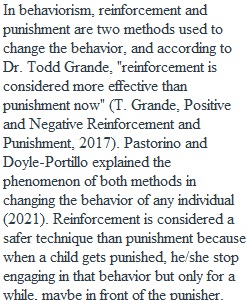


Q The purpose of this reflection is to highlight a piece of content from the course and begin using APA format in our writing. Like a needle and thread stitching together two pieces of fabric, you will bring together information from multiple sources to present one idea. Your reflection should be at least 350 words and you should provide a word count at the end of the reflection. Step 1 - Select a topic: Think of the topic you have found most interesting thus far in the semester. Step 2 - Select a quote from a lecture video, a live lesson, or a related video from outside the class content such as videos from library resources or reputable news or research organizations. It may be possible to use YouTube videos, but they must be from reputable and scholarly sources. • Select a quote from one of the video lectures on the topic you found most interesting. Type out the quote, be sure to use quotation marks, and begin with some kind of introductory statement. • Be sure to specify the source of the video and end with the year the video was produced. If the date is not available, use (N.D.) to indicate no date. In the lecture video titled Neurons and Neural Communication, Professor Valladares explains that, "we are born with approximately 86 billion neurons" (2020). • The full reference in your references list should look like this: Person or group who uploaded video. (Date of publication). Title of video [Video]. Website host. URL Example: Tasty. (2018, March 7). 7 recipes you can make in 5 minutes [Video]. Youtube. https://www.youtube.com/watch?v=9_5wHw6l11oLinks to an external site. When these pieces are put together, the passage should look like this: According to Professor Valladares, "we are born with approximately 86 billion neurons" (J. Valladares, Lecture 2: Neural communication, 2020). Step 3: Select a passage in the textbook: Find the section in the course textbook that corresponds with the topic you selected. Select a passage in the book and paraphrase it to capture the essence of what the passage conveys. Do not use quotes in this part - use your own words to describe the ideas. Again, use in-text citations. For example: Neurons are specialized cells that carry information within the brain and between the brain and body (Pastorino & Doyle Portillo, 2019). Pastorino and Doyle-Portillo highlight the example of how neural networks respond when we touch a hot stove in order to generate a reflexive reaction (2019). Step 4: Describe your interest in the topic you selected. Write a paragraph explaining your interest in the topic. Here are some prompts to help you fill in a paragraph: • Why is this interesting? • Is this the first time you have learned about this? If not, where did you learn about this before? • How does it relate to your everyday life? • Does it make you wonder about other things? What other things? Example: It was interesting to learn that we have so many cells that compose this important organ. I first learned about neurons in my biology class, but I don't think I fully understood how many we had and how important of a role they play in who we are and what we do. Learning about this makes me consider how my neurons are interacting when I do things like play music, play basketball, or watch videos on my phone. I wonder how the activity of my neurons changes with experience and age. Step 5: Write your reflection and post it to the discussion. Combine the elements from the previous steps to compose a scholarly paragraph describing this area of interest. This should have no spieling or grammar errors, should use appropriate punctuation and capitalization, and appropriate citation. Do not plagiarize on this assignment. Click "Reply" below and post your completed reflection in the discussion board. Here is an example of what a reflection could look like: Our brain cells can have an enormously large number of connections. According to Jorge Valladares, a professor of psychology at Valencia College, "we are born with approximately 86 billion neurons, and each neuron can have nearly ten-thousand connections" (J. Valladares, Lecture 2: Neural communication, 2020). Neurons are specialized cells that carry information within the brain and between the brain and body (Pastorino & Doyle Portillo, 2019). Pastorino and Doyle-Portillo highlight the example of how neural networks respond when we touch a hot stove in order to generate a reflexive reaction (2019). It was interesting to learn that we have so many cells that compose this important organ. I first learned about neurons in my biology class, but I don't think I fully understood how many we had and how important of a role they play in who we are and what we do. Learning about this makes me consider how my neurons are interacting when I do things like play music, play basketball, or watch videos on my phone. I wonder how the activity of my neurons changes with experience and age. Step 6: List you references. At the end of your reflection post, provide a list of the references used in your writing using APA format. For additional guidance on using APA format, visit our library's resource for writing: https://valenciacollege.edu/students/library/mla-apa-chicago-guides/apacitation.phpLinks to an external site. Also, the OWL at Perdue provides an excellent interactive guide to using APA: https://owl.purdue.edu/owl/research_and_citation/apa_style/apa_style_introduction.htmlLinks to an external site.
View Related Questions